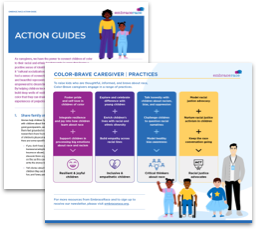4 Ways to Build Children’s Empathy Across Racial Lines
At first glance, it might not seem like our children need much help with empathy. In some ways, kids are wired for empathy right from the start, as we can see when a toddler gives a comforting hug to a crying friend. On the other hand, our empathy is biased: it is often easier to empathize with members of our own groups -- people who look like us, talk like us, or share some key identity -- compared to others. The tips here provide some ideas about how to make the most of children’s natural capacity for empathy to connect them across racial lines and motivate them to stand up for racial equity and justice.
Activity Ideas
-
The most powerful way to build empathy across racial lines is through meaningful relationships.
Do your best to make sure children have opportunities to build cross-group friendships (and that they see you building and enjoying your own). Families can be mindful of the diversity of the playgroups they join and educators can be mindful of the diversity of the peer groups they organize.
-
Young children interacting with diverse others will come to see others who look different as having their own thoughts, interests, and feelings, and can be encouraged to practice sharing, kind gestures, and fairness across racial lines.
-
As children grow, cross-group friendships involving personal information sharing will open windows into the lives of people from different backgrounds, along with opportunities to support each other and build trust and intimacy.
Through these emotional processes, we can broaden the range of people we feel are worthy of our care and compassion.
Activity Ideas
-
When reading books or watching movies, ask children questions that prompt them to “put themself in someone else’s shoes” and take the perspectives of others.
For example: “How do you think [the character] feels? How would you feel if someone treated you like that?” Pay close attention to body language in illustrations that can communicate how someone is feeling.
-
If children have never experienced the kind of thing you’re reading about, break it down into terms they can understand and relate to.
“Do you like to be told what to do all the time?” “How do you feel when [sibling] doesn’t let you have a turn?” “What if someone said you couldn’t see Daddy anymore? How would that make you feel?”
-
Focus on the full range of emotions.
Of course, it’s important to prompt perspective-taking when someone is being treated unfairly and experiencing racism or discrimination, but it’s also important to prompt empathy with characters’ positive feelings of joy and pride, and everyday feelings like nervousness or frustration. This way, we encourage children to perceive others as relatable human beings with a full range of emotional experiences--just like them!
Activity Ideas
-
Help make the connection between individuals being empathized with in stories to larger groups and systems of oppression.
“Do you think that actually happens in the real world?” or “Have you ever seen or heard about something like that in real life?”
-
Ask children what they see at school or at the playground.
This will help bring these issues to life in their personal world, which often increases the potential to practice and strengthen our empathy skills. Are any children excluded or left out? Is anyone being teased? Why? Is that fair? How can we show compassion or stand up for those children?
-
Use empathy wisely.
If we try, humans have the capacity to empathize with just about anyone (and even things!). But that doesn’t mean that everyone is right and no one should be held accountable for doing harm. By connecting empathy back to family values and the kind of world we want to build, we can guide our moral choices.
Activity Ideas
-
Make sure empathy doesn’t stop at feelings!
Feeling for someone is a start, but it isn’t enough. It is our responsibility to help channel empathy into compassionate action, helping people and changing systems. See our action guides, 5 Ways to Support Young Children in Standing Up for Racial Justice and 7 Ways to Support the Young Activists in Your Life, for some ideas about supporting children’s activism.
-
Take a break.
Experiencing high levels of empathy all the time can be exhausting, and can even lead to avoidance of people or topics that prompt it. Help ensure you’re not burning out or overloading your children by taking a break with meaningful rest and restoring, nourishing activities. This purposeful self-care is crucial for helping ourselves and our children engage actively in line with our values and for the long haul.
Bloom, P. (2017). Against empathy: The case for rational compassion. Random House.
Contreras-Huerta, L. S., Baker, K. S., Reynolds, K. J., Batalha, L., & Cunnington, R. (2013). Racial bias in neural empathic responses to pain. PloS one, 8(12), e84001. https://doi.org/10.1371/journal.pone.0084001
Killen, M., Luken Raz, K., & Graham, S. (2021). Reducing prejudice through promoting cross-group friendships. Review of General Psychology, 10892680211061262. https://doi.org/10.1177/10892680211061262
Turner, R. N., Hewstone, M., & Voci, A. (2007). Reducing explicit and implicit outgroup prejudice via direct and extended contact: The mediating role of self-disclosure and intergroup anxiety. Journal of personality and social psychology, 93(3), 369-388. https://doi.org/10.1037/0022-3514.93.3.369
Wee, S. J., Kim, S. J., Chung, K., & Kim, M. (2021). Development of children’s perspective-taking and empathy through bullying-themed books and role-playing. Journal of Research in Childhood Education, 36(1), 96-111. https://doi.org/10.1080/02568543.2020.1864523
